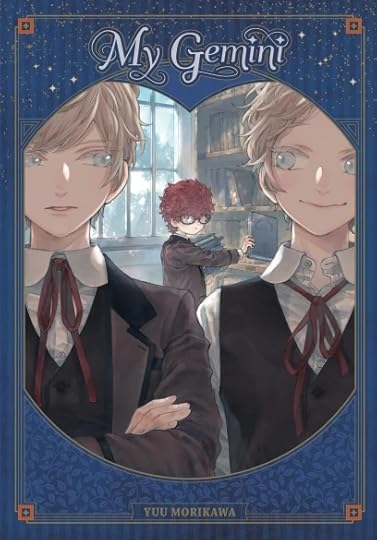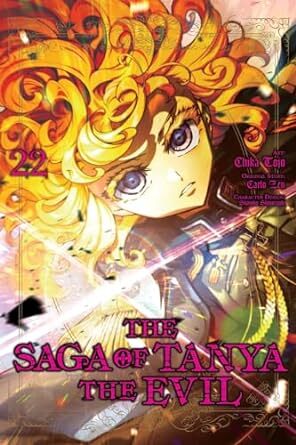S.Q. Eries's Blog, page 6
July 2, 2024
Manga Review: My Gemini
 Manga about twins are fairly commonplace, but how about a pair based off Dr. Jekyll and Mr. Hyde? That’s the premise of the standalone manga My Gemini. Read on for the review!
Manga about twins are fairly commonplace, but how about a pair based off Dr. Jekyll and Mr. Hyde? That’s the premise of the standalone manga My Gemini. Read on for the review!
Plain, redheaded, and freckled John has nothing going for him, except there’s one thing he’s proud of―he’s best friends with the two popular and mischievous twins Jekyll and Hyde. Jekyll (the calm and collected older brother) and Hyde (the cheerful younger brother) love switching places, and John is the only one who can tell them apart. But when the pair is fragmented by an untimely death, one twin is left alone without his “other self” by his side. The only question is―is he Jekyll, or is he Hyde?
The ReviewJohn Utterson attends a British boarding school where he is best friends with the Stevenson twins: the prim and proper Jekyll and the charming and carefree Hyde. The twins frequently swap personas, and no one is the wiser, except for John, who can tell them apart no matter what. So when a Stevenson brother dies in an accident, John is the only one who realizes the surviving twin isn’t who everyone thinks he is…
It’s a little difficult to categorize this as a standalone story. Perhaps British boarding school mystery drama? But the mystery isn’t the typical whodunit where someone dies and characters track down the killer. Rather, a twin dies under absolutely non-suspicious circumstances, and you have to figure out who the remaining twin actually is. More importantly, you have to figure out why he behaves as he does.
Despite the character names, Hyde is not evil, and the narrative involves no nefarious schemes. However, the twins mirror the original Doctor Jekyll and Mr. Hyde in that the personalities they show the world are their joint creation, those personas are vastly different and distinct, and they can be assumed by either brother. While the twins and John treat these switcheroos as a fun game, things take on a much somber tone when one brother dies in an accident. Everyone believes Jekyll is the deceased Stevenson twin, but not long after the funeral, John realizes “Hyde” is actually Jekyll impersonating his brother.
The first part of the story has John – the one person to realize the truth of “Hyde’s” identity–watching over his bereaved friend and wondering why he’s continuing to playact his brother. The exchange of letters signed “Jekyll” and the run-ins with the prefects Benjamin and Roche in this initial arc are somewhat confusing. However, these events set the stage for “Hyde” to receive a cryptic message from Roche, a message that makes him realize his twin had been hiding something from him.
Things get more interesting from that point on as “Hyde” and John work together to get to the bottom of this secret. The deeper they dig, the more they find themselves questioning whether the bonds of friendship and brotherhood they thought they shared were genuine. This mystery primarily gets unraveled through flashbacks and conversations that take place at their family homes and at school. So there are no great adventures, and despite the students’ ghost stories, no supernatural elements.
Regarding illustrations, the manga does a nice job with the Victorian-era clothing and a British boarding school setting. The all-male cast is heavy on bishounen. Even John, who describes himself as plain, comes off as cute. Expressions are spot on, drawings brim with emotion, and you can always tell which “persona” the brothers are assuming.
Extras include the title page printed in color and afterword.
In SummaryThis is a story about secrets between friends and between brothers. So despite the character names, there’s no psycho murdering people. Rather, it’s about how jealousy and longing can warp identity and perception. If a melancholy tale with a classic Victorian boarding school setting appeals to you, this title is worth a try.
First published at the Fandom Post.
June 25, 2024
Manga Review: The Villainess Stans the Heroes: Playing the Antagonist to Support Her Faves! Vol. #3
 Isekai has really overtaken the anime/manga scene the last several years. The Villainess Stans the Heroes: Playing the Antagonist to Support Her Faves! is one such title. Read on for my review of Volume 3. (For other reviews from this series, click here.)
Isekai has really overtaken the anime/manga scene the last several years. The Villainess Stans the Heroes: Playing the Antagonist to Support Her Faves! is one such title. Read on for my review of Volume 3. (For other reviews from this series, click here.)
With the hero’s party and the Ordi family on standby, Operation: Destroy the Dirty Casino is a go! Except…something doesn’t seem right. It’s almost like another mastermind is pulling the strings, and if my hunch is correct, it’s a character who’s not supposed to show up in this particular connection story. I’ll have to figure out what the deal is with all these disparities later, though, because first things first—the prince has been kidnapped! I may not be a knight in shining armor, but this dashing young villainess is coming to his rescue!
The ReviewVolume 3 continues the casino arc with our villainess infiltrating the masquerade/black market auction. Because everyone is dressed in costumes and masks, much of the first chapter is simply her swooning over her faves’ disguises. Although Chikusa’s prized blade is at stake, the narrative spends hardly any time on its recovery. Chikusa gets her sword back without bothering to show the bidding process. Between that and a running joke about all the stuff Ellua has stored in her skirts, the atmosphere stays fairly lighthearted.
The mood changes though when Ellua notices things at the auction are deviating significantly from the original script. Then things really take a turn when she realizes Albert’s connection story is already underway.
Enter Vlad Chagrin, Originator of Vampires. He is the boss of Albert’s connection story, and with his appearance comes a huge problem. In the game, the hero and Albert defeat Vlad together. However, because of Ellua’s meddling, Albert has no connection with the hero. And before Ellua can react to this dilemma, Vlad abducts Albert.
Thus, Ellua must scramble for a way to defeat Vlad by substituting herself into Albert’s connection story. Despite the desperate situation, the pacing gets bogged by the new enemy’s backstory and Ellua’s fangirling. In terms of personality, Vlad makes a pretty flat villain, and his vampiric hordes behave more like zombies than an elite fighting force. And when Ellua and Albert team up against Vlad, it’s more trash talk than actual action. Still, having Ellua in a situation where she doesn’t know the outcome is a nice change. Plus, Ellua/Albert fans will enjoy watching them risk everything to fight for each other.
Extras include the first page in color, artwork on the inside covers, three pages of bonus comics, and author afterward.
In SummaryEllua heads to the black market auction so she can ogle over everyone’s masquerade outfits and interactions. But what starts off as a swoon fest over her faves turns into a desperate situation when Albert gets abducted by the Originator of Vampires. With the story steadily diverging from the original plot, Ellua’s goal of making sure her heroes reach a happy ending looks like it’s going to get much more challenging.
First published at the Fandom Post.
June 18, 2024
Manga Review: Saga of Tanya the Evil Vol. #22
 The Saga of Tanya the Evil anime was a surprise favorite for me in 2017. With a title like that, I was almost too scared to give it a try, but conniving little Tanya turned out to be nothing like I anticipated. Yen Press has released Volume 22 of the manga adaption, and you can read on for the review. (For my reviews of other Tanya the Evil works, click here.)
The Saga of Tanya the Evil anime was a surprise favorite for me in 2017. With a title like that, I was almost too scared to give it a try, but conniving little Tanya turned out to be nothing like I anticipated. Yen Press has released Volume 22 of the manga adaption, and you can read on for the review. (For my reviews of other Tanya the Evil works, click here.)
It’s all storm and stress for the Free François Republic, as the Imperial Southern Continent Expeditionary Army Corps advances lightning-quick across the Republic’s colonial holdouts. General Romel sends forth wave after wave of unconventional maneuvers, and it’s not long before Tanya’s 203rd Aerial Mage Battalion is part of the tide…!
The ReviewThis volume begins by turning the clock back to 20 days before Major General Romel makes his rapid advance into the Southern Continent. Previous chapters indicated how keenly Tanya’s superiors regretted ignoring her warning about the Republican forces, and that regret continues to gnaw at them in Volume 22’s opening as they strategize against the escaped Republicans and the new threat of the Commonwealth. The light novels revealed little about the higher-ups’ perspectives on the Brest incident, and the anime touched on it only briefly, which I always thought unfair to Tanya. So I appreciate that the manga shows her superiors suffering the mental anguish of their decision.
Then the focus shifts from the generals in the war room to the general in the field, Romel. I enjoyed this arc in the light novel; it’s rare for Tanya to view a superior in the field so positively. As such, I was quite disappointed when the anime glossed over the Southern Campaign. (I’m not even sure if Romel made an actual appearance in the anime.) The manga, on the other hand, unabashedly thrusts General Romel into the spotlight. In fact, Volume 22 is more about him than Tanya. Having advanced far deeper than anticipated, the head of the Imperial Southern Campaign must now work out problems in his supply chain; deceive and intimidate his enemies; and herd up all the stragglers that couldn’t keep up with him in the desert. The manga uses these tasks not only to demonstrate how brilliant and unconventional he is at his job, but also show off his colorful personality and how it inspires loyalty and admiration even with someone like Tanya. Personally, I can’t get enough of the guy.
The final two chapters are a comedy of the disoriented as General Romel flies out on a recon plane escorted by Grantz’s mage platoon to personally search for a missing battalion. While you’ll have to suspend belief that allies and enemies of different tongues can communicate so easily, their blundering initial contact is hilarious. In between the funny bits is a rare interaction between the young mages and the highest commander on the Southern Continent. Without intending to, Grantz and company earn Romel’s deepest respect, and Grantz recognizes in Romel the same extraordinary power of perception as Tanya’s. The way the mangaka brings all this together is brilliant, and I can’t wait for more.
Extras include world map, battle log thus far, character introductions (in ridiculously small font), profile for the 203rd Battalion, country profiles, profile of the Imperial Southern Continent Expeditionary Army Corps, status of each country (also in ridiculously small font), and chapter glossaries (although the referenced chapter numbers appear to be incorrect).
In SummaryTanya’s superiors are still kicking themselves for the victory they let slip through their fingers. Tanya, though, has moved past regret and is firmly focused on the task at hand: surviving in the Southern Continent against Republican and Commonwealth forces. Fortunately, she is under the command of the extraordinary General Romel. These chapters show that the man is as brilliant off the battlefield as he is on it. He has his own style of leadership, and watching him get things done is a ton of fun.
First published at the Fandom Post.
June 11, 2024
Manhwa Review: The Remarried Empress Vol. 6
 Lots of Korean web comics and web fiction are successfully making the jump from the Internet to traditional media nowadays. One of these is The Remarried Empress. Read on for the review of Volume 6 of the manhwa. (For other reviews of this series, click here.)
Lots of Korean web comics and web fiction are successfully making the jump from the Internet to traditional media nowadays. One of these is The Remarried Empress. Read on for the review of Volume 6 of the manhwa. (For other reviews of this series, click here.)
Navier and Heinrey have agreed to marry! Heinrey is over the moon, despite the political nature of their initial arrangement, but Navier is still reeling from Sovieshu’s decision to separate. She must scramble to recover, though, knowing full well that the emperor will do everything in his power to prevent their union. And so, when the day of the formal trial arrives, Navier brandishes her and Heinrey’s trump card―“I accept this divorce… and request an approval for my remarriage!”
The ReviewThe Emperor plows ahead with his scheme to replace Navier with Rashta as a legitimate empress. Unbeknownst to him, Heinrey forges ahead with his own plans to secure the safety of Navier’s brother (and put himself into her family’s good graces). Thus, the narrative hurtles toward the divorce proceedings we glimpsed in Volume 1.
However, before that extremely public trial, the High Priest responsible for the proceedings speaks privately to the Emperor. Like most observers, the priest is baffled by the Emperor’s determination to cast his wife aside and tries to talk him out of it. That’s when we finally learn Sovieshu’s motivation for cooking up such a convoluted plan to divorce and reinstate Navier.
Previously, the Emperor seemed an incredibly selfish and controlling person. Once he reveals what happened to him and Navier as children, he seems like an incredible idiot, and a deceitful one at that. He tells his secret in a bid for sympathy, but he didn’t get mine. After all, he could have handled the situation so many other ways (like telling Navier the truth so she could actually cooperate with a solution). The fact that he is hiding the truth and securing an heir with someone who’s so unqualified and disrespectful toward his wife paints him as both unwise and despicable.
At any rate, by the time the divorce proceedings begin, you’ll be thoroughly fed up with the Emperor. Heinrey’s surprise appearance at the trial is a much bigger deal than one might realize in Volume 1, and it is extremely satisfying when the High Priest sides with Navier and marries her to Heinrey.
Sovieshu has mostly treated Navier in public with cold indifference, so it’s out of character when he gets wildly emotional in the courtroom, spouting outbursts of how Navier is his wife and he won’t let another man take her. His behavior is more fitting for a thoughtless child than the head of an empire, and the fact that he can’t control himself diminishes him further as a ruler in my eyes. Unfortunately, because he is the highest ranked person in the country, he can and does continue to interfere with Navier and Heinrey’s union, although even he has to recognize his actions put him on dicey political grounds.
In contrast to Sovieshu is Heinrey, who’s going above and beyond to make Navier feel loved and put her worries at ease. And then there are Navier’s allies, who rally to help and celebrate with her as she leaves her marriage on her terms. Volume 6 does not mark the end of the series, but the former empress has certainly triumphed over her now ex-husband as she gets a new partner and lease on life.
In SummaryPrior to the divorce proceedings, the Emperor confides to the High Priest his true reason for divorcing Navier. But instead of earning sympathy, he comes off looking like a fool. He looks an even bigger fool, though, when Heinrey and Navier foil his plans to control Navier after their marriage is dissolved. The obstacles and troubles Navier’s faced have been numerous, so when she and Heinrey come out on top, you can’t help but wish them well.
First published at the Fandom Post.
June 4, 2024
Light Novel Review: Sasaki and Peeps Vol. 6
 Isekai, sci-fi, and fantasy are huge light novel genres. But how about a mash-up of all three? That’s what you’ll find in Sasaki and Peeps! Read on for the review of Volume 6. (For other Sasaki and Peeps reviews, click here.)
Isekai, sci-fi, and fantasy are huge light novel genres. But how about a mash-up of all three? That’s what you’ll find in Sasaki and Peeps! Read on for the review of Volume 6. (For other Sasaki and Peeps reviews, click here.)
With the Herzian succession dispute now settled, Sasaki and Peeps head back to modern Japan just in time for a new case at the bureau. Along with Futarishizuka and Hoshizaki, Sasaki is tasked with investigating a series of recent UFO sightings, and for once the assignment appears to have nothing to do with the otherworld. Exhausted from their earlier ordeals and lacking clues, the crew decide to take it slow and leave the heavy lifting to the experts. But for better or worse, they seem destined to wind up in the spotlight, as yet another powerful faction explodes onto the scene!
The ReviewI thought this series had hit its capacity for sci-fi and fantasy elements, but I was wrong. With Volume 6, we have the introduction of UFOs to the modern world, along with wildly advanced alien AI. And not just any AI, but the super logical type that has developed the bug called emotions, leading to terrifying destructive results. Predictably (and annoyingly), the form this AI takes among Sasaki and company is of a gorgeous teenage girl in accordance with the series’ particular brand of fanservice. (Even Hoshizaki’s younger sister calls Sasaki out as a “weirdo” who’s always hanging around young girls in this volume).
Anyway, this UFO arc reads sluggishly overall. Unlike the situation with the Octodragon, the UFO has no connections with Sasaki or his varied friends. As such, there is a lengthy setup with the Bureau calling Sasaki, Futarishizuka, and Hoshizaki to do an independent investigation of the UFO; a bunch of data crunching by the sparrow starsage; and Futarishizuka showing off her knowledge of radio equipment. This finally culminates in an unexpected and funny alien abduction in a swan boat. However, the three Bureau members apparently aren’t the only humans involved in this first contact. So once aboard the UFO, there’s again a ton of passive observing and random chatter before Sasaki and his psychic colleagues encounter their alien host, Type Twelve, a super advanced android with the emotional maturity of a baby.
In terms of their exchange, it’s not particularly original. The Bureau employees’ special powers aside, the encounter is fairly similar to other sci-fi works where humans must deal with computer systems destabilizing due to the introduction of “feelings.” The conversation tends to drag due to all the information dumped in, and as if to make up for it, the story shifts into overdrive when the alien ultimately decides to destroy humanity and jettison all the abducted humans into outer space.
Thanks to psychic/Magical Girl powers, many of those humans, including all of Sasaki’s group, survive, only to have to tell their respective organizations the planet is in imminent danger. Once again, the pace slows to a crawl as the narrative details everyone’s responses. Then things rev up for a final nighttime Battle Royale involving all the paranormal elements thus introduced into the series. Unfortunately, creating a clash where our main character get mixed up with government agencies, Magical Girls, an Angel/Demon isolated space, psychics, and an alien takes a while. So despite the fate-of-the-world-depends-on-it stakes, this epic fight gets a bit slow (and confusing) toward the end.
The first eight pages, which contain illustrations and a thread from Lady Elsa’s social media, are printed in full color. Extras also include a summary of events thus far, nine black-and-white insert illustrations, an afterword, a character profile of Type Twelve, and a text exchange between Peeps and Sasaki about the anime adaption.
In SummaryJust when you thought the cast couldn’t get larger or more varied, alien android Type Twelve makes her appearance. The volume’s first half detailing initial UFO sightings and investigations drags and isn’t particularly original compared to other sci-fi works. However, the second half is more interesting with Type Twelve’s reactions to the planet anomalies that are psychics, Disciples, and Magical Girls.
First published at the Fandom Post.
May 28, 2024
Manga Review: Tales of the Tendo Family Vol. 1
 If Demon Slayer has you looking for more manga set in that historical era, Tales of the Tendo Family might be worth a look. Read on for the review of Volume 1.
If Demon Slayer has you looking for more manga set in that historical era, Tales of the Tendo Family might be worth a look. Read on for the review of Volume 1.
Masato, a son of the Tendo family, is meant to marry Hojo Ran, the daughter of a baron. There’s just one problem: she’s a fake. The real Ran has fled after hearing that few make it out of the Tendo family alive. In her place is a young woman who says she will die if it means saving someone else’s life.
The ReviewWhen a teenage orphan saves a noblewoman from drowning, she’s stunned to learn it was a suicide attempt. The noblewoman, Hojo Ran, is betrothed to Tenjo Masato, whose family is embroiled in a bloody succession dispute, and Ran felt that death was preferable to getting caught up in that struggle. Upon hearing this, Ran’s rescuer volunteers to take her place. Unfortunately, the groom immediately sees through the fake bride’s ruse!
This is a shojo historical that is set in the Meiji or Taisho era; has a rich, handsome, and twisted male lead; and features a cheerful, spunky orphan heroine. Within the first few pages, you can tell she’s the good-hearted type, but her concern for others initially comes off as outrageously extreme. As much as a person might sympathize with another, who would actually risk their neck for a stranger they’ve just met? Especially if they’re not getting anything in return. However, the motivation behind the heroine’s bizarre actions comes to light at the end of Chapter 1 when we discover the girl has a death wish.
Like she really does want to die. Nameless and abandoned by her parents, she was raised by an old man who treated her as his own. So when her adoptive grandfather died, she set her mind on following him to the afterlife.
So she’s a bit different than your typical cheerful, spunky orphan. Moreover, the codger that raised her taught her a thing or two about martial arts. When an assassin attacks the fake bride in the Tendo estate, she knocks him out, no problem. Unfortunately, her ability to fight seems to conveniently come and go. When Tachibana, Masato’s right-hand man, spars with her while she is blindfolded, she defeats him easily. However, in another scene, Masato orders Tachibana to forcibly give her a bath with the end result that she flees naked around the house. I believe the scene was intended to be comic, but I found it lacking in taste.
Compared to her, our male lead is more conventional. He’s born to a rich, dysfunctional family. Although he’s only 16, he’s got a ruthless aura and hardened attitude. (The way Saito-sensei drew him, I originally thought he was in his mid-20s!) His father, the family head, is on his deathbed. He’s got an uncle out to publicly humiliate him and an aunt with an unhealthy obsession for Masato. It’s unclear for now who Masato’s most powerful enemies are, but Masato’s mother was a commoner, which would automatically put him at a disadvantage in this kind of conflict. Unlike our heroine, he’s determined to live in order to accomplish his goal, and when he realizes how valuable her abilities would be, he has no qualms about manipulating her into keeping up the role of his bride.
So this is not a Taisho Cinderella story. By the end of the volume, there’s been one attempt on Masato’s life and two on his fake bride’s. Still, for those who enjoy this kind of succession drama against the backdrop of high society, there are tea parties and elegant attire aplenty as the intrigue plays out.
Extras include illustrations embedded in the chapters and a bonus story at the end. The font is a bit on the small side, and the formatting is off in a couple of places. Cultural notes are provided as footnotes.
In SummaryA young girl marries into a wealthy family embroiled in a bloody succession dispute. However, this bride’s a fake! Instead of a meek noblewoman, a fearless commoner is in her place – and her ruthless fiancé sees this substitute as a useful tool. While I can see how the unlikely pair might end up romantically involved, they’ll have to deal with assassination attempts first.
First published at The Fandom Post.
May 21, 2024
Manhwa Review: My Gently Raised Beast Vol. 5
 Lots of Korean web comics and web fiction are successfully making the jump from the Internet to traditional media nowadays. One of these is My Gently Raised Beast. Read on for the review of Volume 5 of the manhwa. (For reviews of other volumes, click here.)
Lots of Korean web comics and web fiction are successfully making the jump from the Internet to traditional media nowadays. One of these is My Gently Raised Beast. Read on for the review of Volume 5 of the manhwa. (For reviews of other volumes, click here.)
Blondina is rescued just in the nick of time by Amon, and her safe return is greeted with much joy and celebration. But not everyone is happy to see her alive and well―when Adellai witnesses all the love and warmth around her half sister, something inside her snaps. Unhinged by jealousy, she redoubles her efforts to destroy Blondina…but not if Amon has anything to say about it! “I will never lose you again, Briddy.”
The ReviewAmon comes to Blondina’s rescue, foiling Adellai’s plans. With this, the story plunges into full royal succession struggle mode. It doesn’t matter that Blondina harbors zero ambitions of taking the crown. She nearly got murdered, and things clearly won’t end there. Thus, sweet, mild Blondina quickly grows a backbone in order to confront first the Dehills and then Adellai. Blondina’s declaration, “What I need right now isn’t someone else’s power, but my own, so I can protect my people,” shows how drastically she’s changed.
In the meantime, Adellai doubles down on her efforts against Blondina and the Divine Beasts. She’s definitely painted as the villain here – not showing the slightest hesitation to eliminate foes and inconvenient allies alike. Although jealousy is at the root of her vehemence, she’s unfortunately starting to feel one-dimensional – spouting the same pompous line about taking back what was stolen from her whether she has the upper hand or in mortal danger.
As for the person at the center of this sibling rivalry, he’s behaving annoyingly out of character in this volume. After Amon returns Blondina to her family, her father suddenly gets a conscience. His very belated guilt over Blondina’s suffering doesn’t feel genuine though. He’s the king for crying out loud. Given his power and resources, he had a whole lot of options if he truly wanted to secure Blondina and her mother’s welfare. The lack of resentment in Blondina’s reception of his apology doesn’t feel genuine either. After all, this is the same gal who was happy to dish punishment to the abusive innkeepers. One could argue that her father’s abandonment was as bad as their behavior or worse. Not to mention, the king has not and still is not doing a thing to quell the hostility between his children. In a sense, he’s to blame for this vicious sibling rivalry, and the man is too oblivious or incompetent to stop it.
In SummaryThe sibling rivalry intensifies! Although Blondina escapes the “stimulant incident” with her life, others involved in the plot do not. Adellai’s quick to kill attitude and maniacal eyes are starting to feel stale, but it is interesting to see Blondina develop into more than a victim who needs rescuing. And although Blondina’s not actually interested in the throne, Lart is. Things are bound to get a lot messier between the three siblings as the power struggle continues.
First published at the Fandom Post.
May 14, 2024
Manga Review: Doomsday With My Dog Vol. 4

There are tons of post-apocalyptic works in the market. But how about one where the last human on earth has conversations with her talking dog? That’s the premise of Doomsday With My Dog. Read on for the review of Volume 4 of the manga. (For other reviews of this series, click here.)
Back Cover BlurbWhat They Say
A high school girl―the last human on Earth―and her loyal canine companion make their way through the prefectures of postapocalyptic Japan, taking in the spectacular sights and meeting the locals―from the furry to the intimidating to the outright bizarre! After all, when there’s no destination, the journey is all the fun!
This final installment of Doomsday with My Dog reminds me a lot of the middle volumes of ZOM 100 with our characters basically taking a post-apocalyptic tour through the different regions of Japan and detailing various cultural and geographic highlights as they go. The main difference is that ZOM 100’s ruined landscape is populated by zombies while Haru and his master encounter the unique fauna and mythical creatures of each region they visit. Part of the journey is just Haru and his master, but for the majority of this sightseeing installment, they are accompanied by the female Shibas (who are still fighting over Haru), the German Shepherd squad, and the fool of the pack Husky.
There is a chapter each for Hokkaido, Aomori, Akita, Iwate, Miyagi, Yamagata, Fukushima, and Niigata. Each chapter opens with an illustration of the characters at a prominent landmark of the prefecture and ends with Haru and his master cosplaying to represent the area. These arcs are packed with references to historical figures, monuments, and local jargon, so most Westerners will be making frequent use of the translation notes, which are pretty good at explaining the cultural references.
The manga concludes with the bonus story “Love Letter,” in which Haru seeks assistance from the Anubis-folk to write a love letter to his master. Previous bonus stories have been tearjerkers, and this one is no different. However, the creator weaves in comedy amid the schmaltz so our characters can end with smiles on their faces.
Extras include translation notes and afterword.
In SummaryIt’s the final volume! Haru and his master wander across Japan, highlighting the unique characteristics of eight prefectures in a way that feels a whole lot like a tourism campaign. Then the series concludes with a heartfelt outpouring of devotion from the Shiba to his master that will make dog lovers laugh and cry.
First published at the Fandom Post.
May 7, 2024
Manhwa Review: A Business Proposal Vol. 4
 Lots of Korean web comics and web fiction are successfully making the jump from the Internet to traditional media nowadays. One of these is A Business Proposal. Read on for the review of Volume 4 of the manhwa. (For other reviews of the series, click here.)
Lots of Korean web comics and web fiction are successfully making the jump from the Internet to traditional media nowadays. One of these is A Business Proposal. Read on for the review of Volume 4 of the manhwa. (For other reviews of the series, click here.)
Hari is about to finally end it with Taemu when disaster strikes. Sudden news of her parents’ accident throws her into a panic, but thankfully, her capable CEO is there to get things under control! Taemu proves with grace and efficiency that he really is good at everything―crisis management, emotional support…and frying chicken…? With her parents in the hospital, Hari needs all the help she can get to keep the restaurant open, and Taemu is determined to use this as a chance to rack up brownie points! However, things get heated when Minwoo joins in, increasingly possessive of his “best friend”…
The ReviewTalk about an emotional roller coaster. Taemu and Hari steam up the first two pages with what was meant to be a goodbye kiss. Fortunately for Taemu, he gets the opportunity to keep the relationship going when Hari gets the sudden news her parents were injured in a kitchen accident. Yes, it is a conveniently timed crisis, but it allows Mr. CEO to demonstrate how serious he is about Hari, both in conventional rich person fashion (taking care of her parents’ medical care) and a more unusual way (rolling up his sleeves at the restaurant to help keep the family business going). Actually, everyone rallies to support Hari and her brother, so the entire swoon-worthy cast ends up in aprons. If you wanted to see the CEO and his secretary frying chicken together, this is your volume!
In addition to the crisis keeping Taemu and Hari together, it allows Sunghoon and Yeongsuh to cross paths and ultimately clear up their misunderstanding. With that, they kiss and make up – in a way that burns up the pages. The book definitely earns its “Older Teen” rating with their bedroom scene at the opening of Chapter 43. So things are just peachy for the pair – except for the fact that Yeongsuh’s dad doesn’t consider Sunghoon ideal husband material. Rich girl’s daddy has made a move yet, but it is imminent.
Also crossing paths during the restaurant crisis are Taemu and Minwoo. After everything poor Hari has been through, it’s satisfying to watch the two guys fight over her in between washing dishes and passing out restaurant flyers. However, the romantic tension with Minwoo comes to an abrupt end when he breaks up with his girlfriend and professes love to Hari. I expected more out of this scene, especially since he is the person Hari has obsessed over so long, but his confession is unexpectedly disappointing. By the end of it, he truly does seem like a squid. But at the very least, it allows Hari to make a clean break from him and focus on her situation with Taemu, which is complicated enough.
In SummaryAn accident at Haha Chicken brings everyone to the restaurant to help Hari keep her family’s business afloat. In between our gorgeous characters dazzling customers as they clean tables and marinate chicken, Sunghoon and Yeongsuh light up the bedroom, and Taemu and Minwoo exhibit jealous behavior over Hari. Ultimately, things with Minwoo come to an unsatisfying and disappointing conclusion, but the progress between Sunghoon/Yeongsuh and Taemu/Hari are plenty to keep the drama going.
First published at the Fandom Post.
April 30, 2024
Manhwa Review: Not-Sew-Wicked Stepmom Vol. #3
 The isekai genre has gotten big enough to spin off subgenres such as the reincarnated villainess. Not-Sew-Wicked Stepmom is an entertaining take on that subgenre that also happens to be a fairytale retelling. Read on for my review of Volume 3. For other reviews from this series, click here.
The isekai genre has gotten big enough to spin off subgenres such as the reincarnated villainess. Not-Sew-Wicked Stepmom is an entertaining take on that subgenre that also happens to be a fairytale retelling. Read on for my review of Volume 3. For other reviews from this series, click here.
Once upon a time, in a kingdom far, far away, there lived a king and queen who absolutely did not get along— or so the people believed! As Foundation Day approaches, pressure mounts on Abigail to show the world that she and Sabrian are a perfectly happy couple. Unfortunately, she’s got her work cut out for her—news of how Sabrian slapped her hand away during their dance practice has reached the ears of the other nobles. With the adorable Princess Blanche there to give them a push, will the king and queen be able to build enough trust in each other to attend the festivities as a united front and successfully put the malicious rumors to rest?
The ReviewAfter Abigail’s attempt at dance practice ends with Sabrian walking out on her, the palace is unsurprisingly abuzz with gossip. While she tries to take it in stride, it’s her faithful mirror Vérité that gets outraged. In addition to his delightfully angry rant on Abigail’s behalf, he suggests divorce. Given the circumstances, Abigail seriously contemplates it even as she worries how it might impact Princess Blanche. Meanwhile, Sabrian’s forced to take stock of the family situation and ultimately decides to come clean with the truth behind his seemingly cold treatment of Abigail.
Previous chapters hinted that the late Queen Miriam had something to do with his behavior, but “physiologically unable to have contact with women” wasn’t exactly what I was expecting. Moreover, Abigail’s surprise (?) when Sabrian points out the age difference between him and his daughter felt odd. After all, Abigail would’ve been privy to that information long before. However, the main point is that the previous “ambitious and greedy” queen saw her sickly 14-year-old husband as a tool and used him accordingly. And that is the key that allows Abigail to see Sabrian not as a coldhearted monster, but a scarred victim.
Thus, the couple’s relationship changes dramatically. They’re still in separate bedrooms, but now that Abigail knows about Sabrian’s internal demons, she offers her utmost sympathy and support. As a result, the little royal family becomes closer and happier than ever. Which means we need new elements to cause trouble. And they both show up at the Foundation Ball.
First is Lady Karen Stoke, younger sister of the late Queen Miriam. Her father tried to persuade the king to take her as an additional wife before, and now she enters the stage to do the convincing herself. At first glance, she appears as ruthlessly ambitious as her father, but as the creator states in the Artist’s Notes, it’s actually because she’s young and naïve and imitating the adults around her. In a different story, she would be a rival for Abigail, but given the king’s– ahem–“affliction,” the girl’s attempt to seduce Sabrian and humiliate Abigail end up as fodder for comedy.
The other troublemaker who’s a bit more difficult to read is Lord Raven, Sabrian’s illegitimate half-brother. He only appears briefly, but that moment is enough to cause a ton of tension. And given that the line of succession is always a source of strife in palace dramas, I suspect he’ll end up center stage at some point.
Extras include Karen’s Character Sheet and Artist’s Notes.
In SummarySabrian reveals to Abigail the reason behind his seemingly cold indifference–and it’s got nothing to do with her. Not even close. Although the confession rather puts the king’s first marriage into a bizarre light, it allows Abigail to extend a helping hand to her husband. With compassion blossoming between the couple, we need something new to cause trouble, and the late queen’s scheming younger sister enters to do the job. Only she’s not so much a villainess as a comic character, so we get another character to laugh at.
First published at the Fandom Post.



